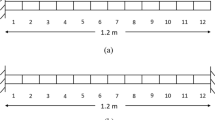Abstract
Integration of Neural Networks (NN) and Fuzzy Logic (FL) have brought researchers from various scientific and engineering domains for the need of developing adaptive intelligent systems to address real time applications. The integration of NN and FL can be classified broadly into three categories namely concurrent model, cooperative model and fully fused model. In the present analysis, fuzzy logic and neural network have been adopted to form a damage identification tool for structural health monitoring for fixed-fixed beam made of steel. The proposed methodology utilizes the modal characteristics of the fixed-fixed beam structure using numerical modeling techniques and anticipates the position and severities of the damage present in the system. The robustness of the proposed technique has been realized by conducting experiments on the steel fixed-fixed beam with different damage characteristics.
Access this chapter
Tax calculation will be finalised at checkout
Purchases are for personal use only
Similar content being viewed by others
Abbreviations
- a1 :
-
= depth of damage
- A:
-
= cross-sectional area of the beam
- Ai (i = 1 to 18) :
-
= unknown coefficients of matrix A
- B:
-
= width of the beam
- C11 :
-
= Axial compliance
- C12 = C21 :
-
= Coupled axial and bending compliance
- C22 :
-
= Bending compliance
- C11 :
-
= Dimensionless form of C11
- C12 = C21 :
-
= Dimensionless form of C12 = C21
- C22 :
-
= Dimensionless form of C22
- \( {\bar{\text{C}}}_{12} \) :
-
= Axial compliance for damage position
- \( {\bar{\text{C}}}_{12} = {\bar{\text{C}}}_{21} \) :
-
= Coupled axial and bending compliance for damage position
- \( {\bar{\text{C}}}_{22} \) :
-
= Bending compliance for damage position
- E:
-
= young’s modulus of elasticity of the beam material
- Fi (i = 1, 2) :
-
= experimentally determined function
- i, j:
-
= variables
- J:
-
= strain-energy release rate
- K1, i (i = 1, 2) :
-
= stress intensity factors for Pi loads
- Kij :
-
= local flexibility matrix elements
- \( K^{\prime} n \) :
-
= Stiffness matrix for damage position
- L:
-
= length of the beam
- L1 :
-
= location (length) of the damage from fixed end
- Pi (i=1,2) :
-
= axial force (i = 1), bending moment (i = 2)
- ui (i=1,2) :
-
= normal functions (longitudinal) ui(x)
- x:
-
= co-ordinate of the beam
- y:
-
= co-ordinate of the beam
- yi (i=1,2) :
-
= normal functions (transverse) yi(x)
- W:
-
= depth of the beam
- ω:
-
= natural circular frequency
- β1 :
-
= relative damage location (L1/L)
- ρ:
-
= mass-density of the beam
References
Meesad, P., Yen, G.G.: Pattern classification by a neurofuzzy network: application to vibration monitoring. ISA Trans. 39(3), 293–308 (2000)
Lucas, C., Far, R.R., Davilu, H., Palade, V.: Model-based fault detection and isolation of a steam generator using neuro-fuzzy networks. Neurocomputing 72(13–15), 2939–2951 (2009)
Zhu, F., Deng, Z., Zhang, J.: An integrated approach for structural damage identification using wavelet neuro-fuzzy model. Expert Syst. Appl. 40(18), 7415–7427 (2013)
Nguyen, S.D., Ngo, K.N., Tran, Q.T., Choi, S.B.: A new method for beam-damage-diagnosis using adaptive fuzzy neural structure and wavelet analysis. Mech. Syst. Signal Process. 39(1–2), 181–194 (2013)
Ayoub, M., Isermann, R.: Neuro-fuzzy systems for diagnosis. Fuzzy Sets Syst. 89(3), 289–307 (1997)
Subbaraj, P., Kannapiran, B.: Fault detection and diagnosis of pneumatic valve using adaptive neuro-fuzzy inference system approach. Appl. Soft Comput. 19, 362–371 (2014)
Chen, J., Roberts, C., Weston, P.: Fault detection and diagnosis for railway track circuits using neuro-fuzzy systems. Control Eng. Pract. 16(5), 585–596 (2008)
Chen, J., Robertsx, C., Weston, P.: Neuro-fuzzy fault detection and diagnosis for railway track circuits. In: Fault Detection, Supervision and Safety of Technical Processes 2006, vol. 2, pp. 1366-1371 (2007)
Zio, E., Gola, G.: A neuro-fuzzy technique for fault diagnosis and its application to rotating machinery. Reliab. Eng. Syst. Saf. 94(1), 78–88 (2009)
Salahshoor, K., Khoshro, M.S., Kordestani, M.: Fault detection and diagnosis of an industrial steam turbine using a distributed configuration of adaptive neuro-fuzzy inference systems. Simul. Model. Pract. Theory 19(5), 1280–1293 (2011)
Salahshoor, K., Kordestani, M., Khoshro, M.S.: Fault detection and diagnosis of an industrial steam turbine using fusion Of SVM (support vector machine) and ANFIS (adaptive neuro-fuzzy inference system) classifiers. Energy 35(12), 5472–5482 (2010)
Sadeghian, M., Fatehi, A.: Identification prediction and detection of the process fault in a cement rotary kiln by locally linear neuro-fuzzy technique. J. Process Control 21(2), 302–308 (2011)
Jiang, S.F., Zhang, C.M., Zhang, S.: Two-stage structural damage detection using fuzzy neural networks and data fusion techniques. Expert Syst. Appl. 38(1), 511–519 (2011)
Palmero, G.I.S., Santamaria, J.J., de la Torre, E.J.M., Gonzalez, J.R.P.: Fault detection and fuzzy rule extraction in ac motors by a neuro-fuzzy art-based system. Eng. Appl. Artif. Intell. 18(7), 867–874 (2005)
Korbicz, J., Kowal, M.: Neuro-fuzzy networks and their application to fault detection of dynamical systems. Eng. Appl. Artif. Intell. 20(5), 609–617 (2007)
Tada, H., Paris, P.C., Irwin, G.R.: The Stress Analysis of Cracks Hand Book. Del Research Corp, Hellertown, Pennsylvania (1973)
Author information
Authors and Affiliations
Corresponding author
Editor information
Editors and Affiliations
Rights and permissions
Copyright information
© 2015 Springer International Publishing Switzerland
About this paper
Cite this paper
Agarwalla, D.K., Dash, A.K., Bhuyan, S.K., Nayak, P.S.K. (2015). Damage Detection of Fixed-Fixed Beam: A Fuzzy Neuro Hybrid System Based Approach. In: Panigrahi, B., Suganthan, P., Das, S. (eds) Swarm, Evolutionary, and Memetic Computing. SEMCCO 2014. Lecture Notes in Computer Science(), vol 8947. Springer, Cham. https://doi.org/10.1007/978-3-319-20294-5_32
Download citation
DOI: https://doi.org/10.1007/978-3-319-20294-5_32
Published:
Publisher Name: Springer, Cham
Print ISBN: 978-3-319-20293-8
Online ISBN: 978-3-319-20294-5
eBook Packages: Computer ScienceComputer Science (R0)




